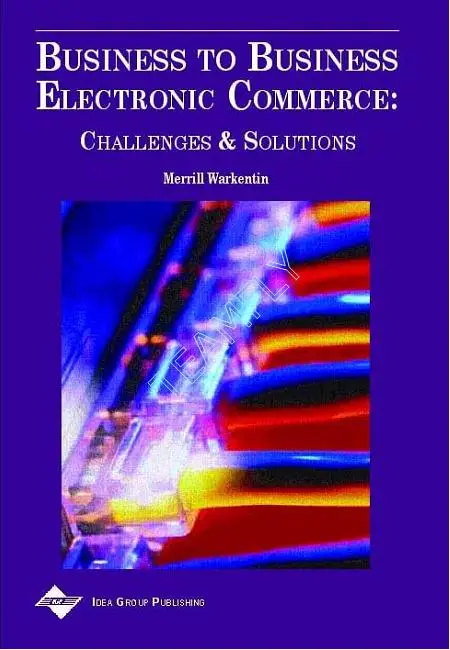Merrill Warkentin
«Business to Business Electronic Commerce: Challenges and Solutions»
Idea Group Publishing | ISBN 1930708092 | (December 24, 2001) | PDF 308 Pages| 1.39 MB
«Business to Business Electronic Commerce: Challenges and Solutions»
Idea Group Publishing | ISBN 1930708092 | (December 24, 2001) | PDF 308 Pages| 1.39 MB
Book Description:
In the mid 1990s, the widespread adoption of the web browser led to a rapid commercialization of the Internet. In addition, initial success stories were reported from companies that learned how to create an effective direct marketing channel – selling tangible products to consumers directly with the World Wide Web. By the end of the 1990s, the next revolution began – called business-to-business electronic commerce. Business to Business Electronic Commerce will provide researchers and practitioners alike with a source of knowledge related to this emerging area of business.
Book Info: Ken Kendall, Rutgers University:
A must read for those decision-makers who want to understand these important new markets and what creates and supports them.
From the Inside Flap:
The growth in the importance of electronic commerce (eCommerce) has been nothing short of phenomenal. Thousands of new companies have created new marketplaces and new opportunities worldwide. The most visible impact to the average consumer is in the explosion of digital content availability and the plethora of new etail sites to purchase everything from books to airline tickets to groceries. However, the growth of business-to-business electronic commerce (B2B eCommerce) has been (and will continue to be) a much more significant business activity of far higher value and will impact nearly all organizations in the long run.
B2B eCommerce activities primarily consist of two categories–those that facilitate the procurement of goods and services and those that provide business infrastructure. Within the broad first category are all the activities and processes that are related to the supply chain. Manufacturing companies purchase raw materials, components, and subassemblies from their suppliers upstream in the supply chain. They also sell their products to other companies who add value through other processes–further assembly, distribution, or sale to consumers. The downstream supply chain partners may include other manufacturers, distributors, wholesalers, dealers, franchisees, retailers (and etailers), and consumers who may “buy direct” from a B2C website such as Dell.com. Manufacturers are not alone–all companies must purchase materials, supplies, and services from various sources. Comprehensively, this network of companies may be termed the value chain or value network. All final sales to consumers of all goods and services are the culmination of a series or network of value-added processes, which include tangible improvements to physical items and less tangible improvements to the value proposition for the consumer.
This first category of B2B eCommerce includes single acts of procurement by one company from another (“one-off sales”) as well as organized online trading exchanges. The exchanges may be operated by an individual company as an avenue to facilitate interaction with all its suppliers. Exchanges may also be organized by an industry consortium using an industry standard set of data representation schemes and protocols. (These have their roots in the electronic data interchange (EDI) efforts in previous decades.) Or they may be created and operated by third-party intermediaries who typically seek profits based on a transaction fee or a subscription fee for participation in the exchange. (Several chapters described below will elaborate on this taxonomy.)
The second category of B2B eCommerce (business infrastructure) includes a variety of business interactions not directly related to the traditional purchase and sale of goods and services in the supply chain or value chain. The value-added services provided through these digital networks create the digital business infrastructure for New Economy companies. In this highly interconnected environment, firms focus on more narrowly defined core competencies and outsource many processes to firms specializing in providing these real-time digital services. These include adserver networks, digital content syndication and configuration, content delivery maximization, website hosting and maintenance, customer acquisition (through affiliate relationships), real-time data mining, order fulfillment, payment processing, encryption, and many other digital processes. In addition, many companies outsource physical processes related to electronic commerce, such as outbound logistics (delivery) and even order fulfillment. Thousands of new companies have been formed in the last four years to provide these digital services (also known as web services or eServices). Some are generic services available to all, while others are industry-specific. These value chain networks will be addressed in the final section of this book.
This book addresses managerial and research issues related to all aspects of B2B eCommerce. The 13 chapters of this volume cover the environment of B2B eCommerce, supply chain management issues, value chain networks, and related research issues in three sections. Topics include EDI, exchanges, trust, manufacturing connectedness, automated tendering, virtual alliances, and B2X networks. The chapters are lively, with examples from industry. They also provide new scholarly perspectives on these important new markets and the processes that create and support them.
The contributions within this book are written by a collection of respected academic scholars from leading universities around the world and also by consultants with extensive experience creating, advising, and evaluating the new companies in this emerging field. Their work will be helpful to managers who seek guidance and insight into the strategic and operational questions arising from participation in this dynamic new environment. The findings contained within these chapters also constitute a valuable resource to researchers who seek to extend their understanding of the principles describing these networks and processes. Further, educators can use this book as a source of teaching material and classroom discussion to prepare tomorrow’s leaders for this emerging New Economy. Finally, public policy analysts and public leaders need to understand this important new driver of economic growth. All students of business from all perspectives will benefit from the rich analysis contained within the chapters of this book.
The first section of this volume addresses the Business-to-Business Electronic Commerce environment. The first chapter provides a valuable framework for understanding the exchanges that have evolved within these emerging marketspaces. An exchange is a new organizational form residing in digital space that acts as an intermediary to enable firms to conduct and engage in online relationships. This chapter proposes a classification scheme for B2B exchanges that attempts to capture the chaos and complexity of today’s B2B relations. It uses multiple implications of this taxonomy for managers to consider, and proposes guidelines for selecting the appropriate exchange mechanism for various business conditions…
About the Author:
Merrill Warkentin is Associate Professor of MIS in the College of Business and Industry at Mississippi State University. He has authored over 100 articles, chapters, and books. His research, primarily in eCommerce, virtual teams, expert systems, and system security, has appeared in such journals as MIS Quarterly, Decision Sciences, Information Systems Journal, Journal of Knowledge Engineering & Technology, Journal of Electronic Commerce Research, Logistics Information Management, ACM Applied Computing Review, Expert Systems, and Journal of Computer Information Systems. Professor Warkentin is a co-author of Electronic Commerce: A Managerial Perspective (2e) (Prentice Hall, 2002) and Editor of Business-to-Business Electronic Commerce: Challenges and Solutions (Idea Group Publishing, 2002). He is currently on the editorial board of Information Resources Management Journal. Dr. Warkentin has served as a consultant to numerous companies and organizations, and has been a featured speaker at over one hundred industry association meetings, executive development seminars, and academic conferences. He has been a Lecturer at the Army Logistics Management College and since 1996, he has served as National Distinguished Lecturer for the Association for Computing Machinery (ACM). Professor Warkentin holds BA, MA, and Ph.D. degrees from the University of Nebraska-Lincoln.



